The gaging stations around Lake Mead serve a multi-fold purpose. Positioned strategically across the lake’s expanse, each station diligently records a stream of vital information.How Many Gauging Stations Are at Lake Mead?
Lake Mead has several gauging stations strategically located to monitor water levels and other hydrological parameters. The exact number of gauging stations can vary, as it depends on the specific needs of water management and monitoring agencies.
These stations help collect data that is essential for understanding the dynamics of Lake Mead’s water levels, enabling informed decision-making and sustainable water resource management. For the most accurate and up-to-date information on the number and locations of gauging stations, it is recommended to check with relevant water management authorities overseeing Lake Mead.
Introduction:
Lake Mead, a jewel nestled near Las Vegas, serves as a critical water source for millions. Its health and stability are monitored closely, utilizing gauging stations and cutting-edge satellite altimetry. These tools gather vital data on water levels, offering insights into trends and future water management needs. In this article, we explore the strategic placement of Lake Mead’s gauging stations and delve into how satellite technology is enhancing our understanding of this invaluable resource.
How Many Gauging Stations Are at Lake Mead
Lake Mead, the largest reservoir in the United States by volume, has several gauging stations to monitor its water levels. These stations play a crucial role in managing water resources in the region. As of my last update, there are multiple gauging stations strategically positioned around the lake to provide accurate data on water levels and flow rates. These stations help authorities make informed decisions regarding water allocation, conservation efforts, and infrastructure management. The number of gauging stations may vary over time due to changes in technology and the evolving needs of water management in the area.
Lake Mead Gaging Stations: An Introduction to Locations and Functions

Nestled within the parched landscape near Las Vegas, the Lake Mead National Recreation Area boasts expansive waters and stunning vistas, making it a haven for both leisure and study. At the heart of its scientific inquiry are the gaging stations dotting Lake Mead’s perimeter.
These sentinel-like structures are crucial for collecting data that informs us about environmental health and resource management for the entire recreation area. Often interchanged with the spelling ‘gauging station’, these sites are pivotal in imparting a clear understanding of water levels, quality, and flow within America’s largest reservoir.
The gaging stations around Lake Mead serve a multi-fold purpose. Positioned strategically across the lake’s expanse, each station diligently records a stream of vital information.
Water enthusiasts and researchers alike depend on the accuracy of these data, which contribute significantly to the operational management of Mead National Recreation Area. But it’s not just for the pros; adventurers and the Virgin Valley denizens also rely on this data for their recreational and life-sustaining activities, respectively.
Satellite altimetry, a component of modern data collection, couples with traditional methods at Lake Mead’s gaging stations, providing a more precise topographical view of the water body.
This synergy of satellite technology and on-the-ground measurements affords a comprehensive analysis of the environmental conditions, beneficial for Lake Mead National. Amid a startling decline in water levels due to prolonged droughts and over-allocation, such data becomes a linchpin for gauging the health of the lake and developing contingency plans.
As intergovernmental agencies and local groups rally to sustain Lake Mead National Recreation’s ecosystem, these gaging stations transform into informational towers, offering real-time snapshots of a dynamic and ever-changing landscape. At each station, professionals work tirelessly in the construction and maintenance of equipment that continuously feeds information about the lake. Site-specific data like the surface acre-foot measurements provide insights into the lake’s capacity and help to project future trends.
Gaging stations are not mere data collection points; they are critical outposts ensuring the safety and sustainability of the recreation area as well as the national recreation pursuits it supports. From regulating water for millions in the Southwestern United States to preserving habitats for diverse wildlife, the stations have a herculean task. They give a quantifiable voice to a natural resource imperative to the survival of the surrounding desert communities.
As we forge ahead, these gaging sites around Lake Mead become more than just mechanisms for measurement. They stand as guardians of a delicate balance, protectors of water in an arid region, and lie at the confluence of human ingenuity and nature’s grandeur. For residents and visitors of Las Vegas and beyond, understanding and supporting the role of these stations is critical for the longevity of the beautiful, yet vulnerable, Lake Mead National Recreation Area.
Exploring the Gaging Stations Near Hoover Dam
Stanley perched on the edge of the vast desert expanse, the iconic Hoover Dam holds back the mighty Colorado River, creating the impressive Lake Mead. This monumental dam, not far from the lights and excitement of Las Vegas, plays a crucial role in the management of the river’s flow and the distribution of water to countless homes and farms.
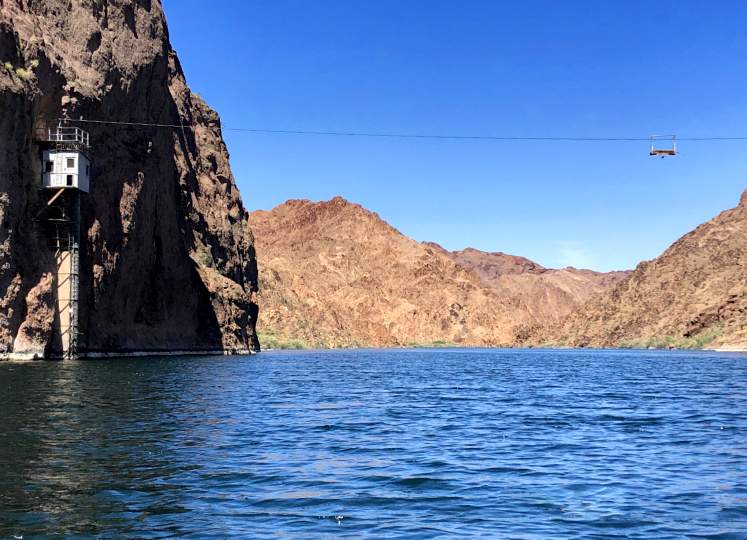
To understand and monitor the health of this water system, a series of strategic gauging stations are placed in crucial spots around Lake Mead, gathering vital data that helps experts gauge the levels and flow of the river. These stations are incredibly important in managing the Hoover Dam’s operations and ensuring the Colorado River’s water is being used wisely. The river itself, which carves through the landscape before reaching the dam, is the same river that sustains life across several states, making the river’s management an issue of paramount importance.
Amidst the intricate web of controls for the Hoover Dam and the Colorado River’s flow, these gauging stations collect various pieces of data. This information includes water levels, flow rates, and even temperature, ensuring that the dam’s operation is both safe and efficient.
These details are crucial because the dam doesn’t just hold water back, it also generates electricity for thousands of people. So, it’s important to keep the river’s levels in check – not too high or too low. Think of these gauging stations as the dam’s vigilant guardians, watching over the river and lake, never sleeping. They guarantee that the water levels remain consistent and the Colorado River’s flow into the dam is just right.
The gauging stations, with their precise instruments, sometimes use satellite altimetry to keep an eye on the shift in water levels from space. This modern technology adds a layer of accuracy, helping experts ensure that the dam’s operations are based on the most current data.
For those curious about where these stations are located around the dam, you’d find them both upstream and downstream, vigilantly keeping watch. The Colorado River, having traveled through canyons and valleys, reaches these stations before it merges into Lake Mead or flows through the Hoover Dam. This incredible system works tirelessly to manage the river’s gift of freshwater, making sure that each drop is accounted for and used effectively.
Next time you’re admiring the grandeur of the Hoover Dam or exploring the Colorado River’s banks, remember the unsung role of these gauging stations. They’re not just part of the scenery; they’re a critical component in the dam’s engineering marvel. Because every river tells its own story, and thanks to these stations, the tale of the Colorado River is one of careful stewardship and wise management, all contributing to the impressive sight of Hoover Dam holding back the vibrant life source that is the Colorado River.
The Science of Measuring Water Levels at Lake Mead
Understanding the science of measuring water levels at Lake Mead is crucial due to its significant impact on water management in the surrounding areas, including Las Vegas. The Reclamation Bureau working alongside the USGS water resources division, has established a sophisticated system to monitor these water levels to ensure that they have accurate and up-to-date information. This becomes more important as Lake Mead’s levels have seen fluctuations due to various factors, including climate change and usage demands.
How Many Gauging Stations Are at Lake Mead process of measuring water involves a combination of traditional gaging stations and high-tech tools like satellite altimetry. Gaging stations around Lake Mead, especially those near Hoover Dam, serve as critical checkpoints for observing water fluctuations. These stations are equipped with instruments to record the water levels, and then this data is used to make decisions regarding water allocation and conservation strategies. The Reclamation Bureau invests in these stations as they are a cornerstone in predicting potential water shortages or planning for future water usage.
Gaging Station Locations
Station 09404200, Colorado River above Diamond Creek near Peach Springs, AZ, is located near the lower end of the Grand Canyon 130 miles upstream from Hoover Dam; both water gains and water losses are expected as the Colorado River flows through the Grand Canyon, but no significant tributaries enter the Colorado River below Diamond Creek so this station should still provide a reasonably good estimate of inflow to Lake Mead. Available and estimated flow data since July 2002, when the Las Vegas Wash station resumed operation, indicate the Colorado River is currently contributing about 96.9% of the flow to Lake Mead.
The Virgin River at Littlefield, AZ (09415000) and Muddy River near Glendale (09419000) stations have historically been used to describe inflows to Lake Mead because of their long periods of record. Station 09415000 is located 58 36 miles upstream of Lake Mead and Station 09419000 is located 16 miles upstream of the lake. Both of the stations significantly overestimate inflow to Lake Mead because agricultural operations between the gages and the lake divert almost the entire flow of both rivers during the summer months. As a result, many previous reports attribute too much flow to these two tributaries.
Two lower stations, 09415250, Virgin River above Lake Mead near Overton, NV, and 09419507, Muddy River at Lewis Avenue at Overton, NV, were installed more recently and are located 4.2 and 5.75 miles, respectively, upstream of Lake Mead to give a much better indication of actual inflows. These stations have only operated for short periods and records are not continuous, but flow data clearly show the impacts of the diversions.
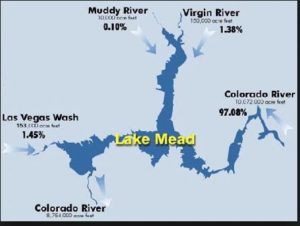
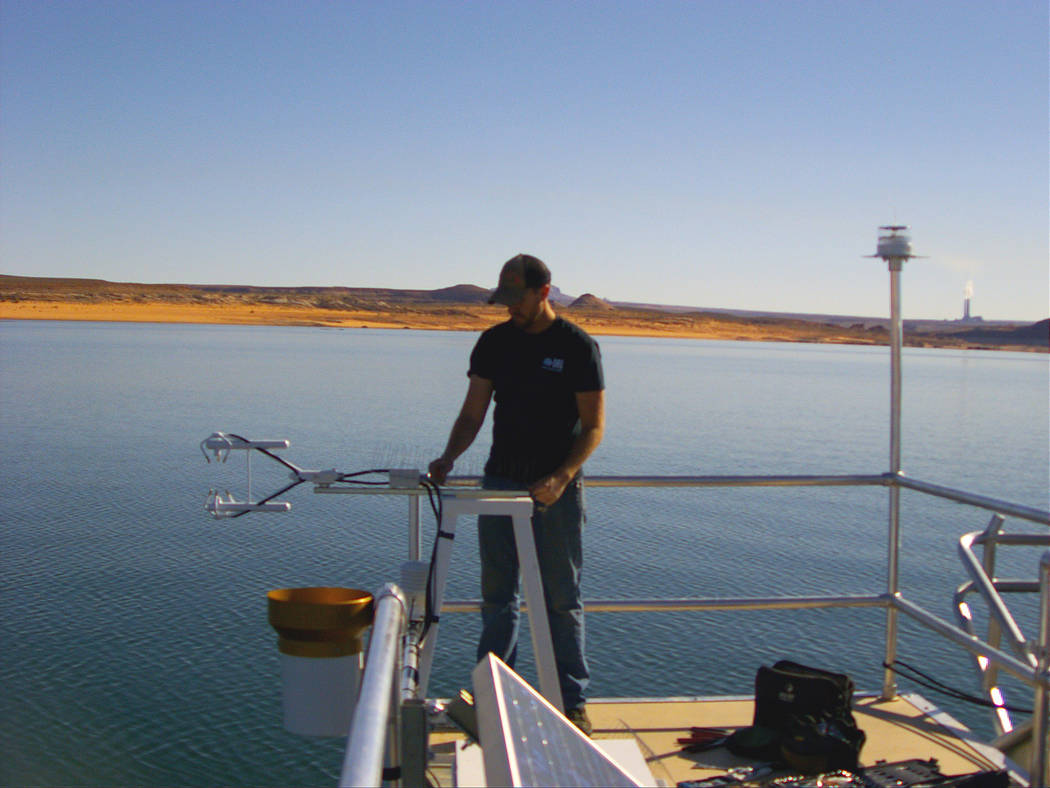
Flows at the downstream Overton, NV, station on the Virgin River averaged 67% of the upstream Littlefield site (range = 0-129%) and the downstream Lewis Avenue site on the Muddy River averaged 40% of the upstream Glendale site (range = 17-53%). Due to falling water levels, the Virgin and Muddy Rivers have been entering Lake Mead as a combined inflow since July 2009.
Satellite altimetry, on the other hand, provides a broader perspective by measuring the water levels of Lake Mead from space. This technology allows scientists to measure the height of the water surface from satellites orbiting the Earth.
By comparing these measurements over time, experts can identify trends in water level changes. This technology complements the ground-based measurements taken by the gaging stations, giving a more comprehensive view of the health and status of Lake Mead’s water resources.
The cooperation between the Reclamation Bureau and the USGS water divisions underscores the significance of accurate water level measurements of Lake Mead.
The data collected from both the gaging stations and satellites are invaluable for researchers, policymakers, and the general public. The process also involves ongoing maintenance and calibration of equipment to ensure that data is reliable. These measurements of water levels guide important decisions regarding water supply safety and sustainability in the region.
In conclusion, accurately measuring the water levels at Lake Mead is a complex science that incorporates the use of both on-site gaging stations and advanced satellite altimetry. The dedication of the Reclamation Bureau and USGS water teams to this task is vital for the management of one of the country’s largest reservoirs. As the pressures on Lake Mead’s water resources continue to grow, so too does the importance of precise and reliable measurements. Ultimately, it’s the combination of high-tech satellite tools and the on-the-ground gaging stations that builds a complete picture of Lake Mead’s water situation, which is essential for a secure water future for Las Vegas and beyond.
Gaging Stations Data Analysis and Satellite Altimetry
Gaging stations at Lake Mead are crucial for monitoring the lake’s health, providing essential data on the water levels and quality. These stations are part of a network managed by the United States Geological Survey (USGS) and contribute to a large databank known as USGS water data. The information they gather is valuable for understanding the dynamics of the lake area, including the storage capacity and the surface area changes over time. This data becomes particularly relevant when we consider Lake Mead’s position within the river basin it occupies, serving as a barometer for the conditions of the Colorado River.
(Satellite Altimetry)-dedicated satellites are equipped with a sensor, which transmits microwave pulses in the radar frequency domain or laser pulses in the optical or infrared domain to the ground and receives the return signals after reflection at Earth’s surface. Because of the favorable reflective properties of water, the radar observation technique is especially suitable over oceans and open water on land. The primary measurement is the satellite-to-water surface round-trip travel time of the signal, multiplied by the speed of light, is equivalent to the round-trip distance. Thus, the range, or distance between the satellite and the instantaneous sea surface is approximately equal to one-half of the two-way travel time multiplied by the speed of light.
Satellite altimetry is another sophisticated tool that complements the traditional gaging stations. By using satellites to measure the time it takes for a radar or laser signal to bounce back from the surface of the lake, scientists get accurate readings of the surface area of Lake Mead. This helps in confirming the data collected by ground stations and provides a more comprehensive picture of the lake’s water levels.
Detailed analysis of the USGS data can reveal patterns in water year trends, which are critical for water management in the Colorado River basin and central Arizona. By understanding these trends, authorities can make better decisions about water use and conservation efforts. Moreover, the data from Lake Mead helps to determine how much water flows downstream to sustain communities and ecosystems reliant on the Colorado River.
Throughout the year, as evaporation, rainfall, and human consumption affect Lake Mead, its storage capacity and surface area fluctuate. These changes are measured in feet (ft), and the data provides insights into how much water is lost or gained during different seasons. This information is particularly useful for predicting water availability and for planning purposes.
The synergy between gaging stations and satellite altimetry ensures that water data is accurate and reliable. It allows for a more nuanced understanding of the water dynamics within Lake Mead, affecting millions of people who depend on it. As water levels in Lake Mead have been of significant concern in recent years, due to prolonged droughts and overuse, this data has become a lynchpin in managing the scarce water resources of the region.
In conclusion, Lake Mead’s gaging stations and satellite altimetry offer a dual approach to monitoring the lake’s condition. They not only provide a wealth of water data but also ensure that the data is precise. This comprehensive strategy is key to managing the lake’s resources, which is a significant component of the Colorado River system that sustains life in central Arizona and beyond. In essence, such diligent analysis of data sustains the intricate balance of nature and human necessity, keeping the lifeblood of this arid region flowing continuously.
Assessing Water Resources: The Role of Lake Mead’s Gaging Stations
Lake Mead is a critical water resource, not just for Las Vegas, but for the entire river basin it serves. The lake’s surface area, once vast and steady, has seen fluctuations that are a cause for concern. To tackle this issue, assessing the water levels, storage capacity, and overall health of the lake is vital.
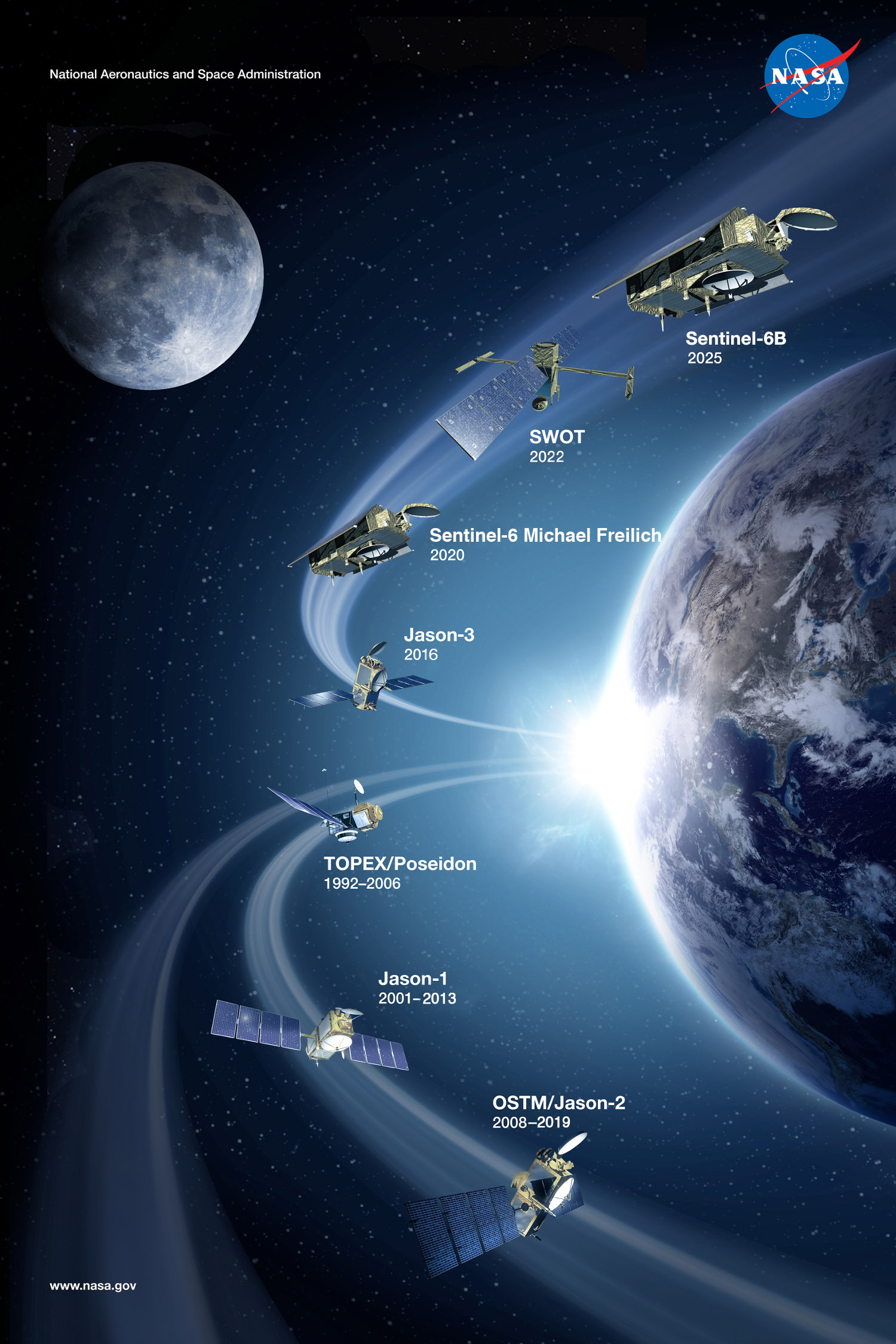
This task is managed by the reclamation bureau and USGS water experts, who rely heavily on Lake Mead’s gaging stations to collect water-chemistry data and monitor the water’s ebb and flow.
Gaging stations, equipped with advanced technology, provide real-time data that tell us not just about the water we see, but about the health of the lake area and the river basin it supports. These stations dotting Lake Mead’s periphery play a significant role in this analysis.
The water’s journey is captured by these gaging stations; from the moment it flows into the lake until it passes Hoover Dam, experts track it closely.
Each gaging station near Lake Mead is strategically placed, ensuring we get an accurate understanding of the water’s behavior. These tools are indispensable in managing Lake Mead’s water resources.
By measuring water levels, the reclamation bureau and researchers can decipher the trends affecting the lake’s surface area and storage capacity.
In addition to on-the-ground measurements, satellite altimetry bolsters our insights by giving us a bird’s-eye view of changes over time. This data is crucial for predicting how the surface area might change and assessing the impact on the water and surrounding communities.
But Lake Mead’s gaging stations don’t work in isolation. They’re part of a larger network of sites collecting USGS water and water-chemistry data from across the entire river basin, ensuring a comprehensive view of the water resources.
Through careful monitoring, the reclamation bureau can forecast and manage the water supply for millions who depend on Lake Mead’s resources.
Whether it’s satellite altimetry fine-tuning our view of the lake area or gaging stations analyzing the flow in the river basin, a combination of human expertise and technological precision is needed to secure Lake Mead’s future.
The water around Lake Mead is more than just a reservoir; it’s a life-sustaining force that irrigates lands, quenches thirst, and generates power.
Whether we’re looking at the water’s surface area, delving into water-chemistry data, or appraising storage capacity, it’s clear that Lake Mead is a hub in the river basin network.
It’s a water haven, the lifeblood of the Reclamation Bureau’s vast water resources management system. So, as we continue to scrutinize the water levels of Lake Mead through the gaging stations, let’s not forget how vital each measurement, each satellite altimetry reading, and each recorded change in the lake area or water chemistry is for the river basin and beyond.
Monitoring Mead: The Importance of Accurate Data Collection
The vast expanse of Lake Mead, near Las Vegas, is a crucial resource, and accurately gauging its depths is paramount for a multitude of reasons. Central to this endeavor are the Lake Mead gauging stations—lifelines that provide critical data regarding water levels, quality, and the overall health of the lake. With the USGS (United States Geological Survey) leading the charge, the gaging stations relay information to the NWIS (National Water Information System), illuminating how water-chemistry data are indispensable in managing Lake Mead’s precious waters.
These stations are sophisticated perched in select locations around the lake, including near iconic structures like the Hoover Dam. It’s here that a combination of science and technology takes place, with gaging stations busily measuring water levels and ensuring the data is both reliable and timely. The water chemistry aspects involve looking into the quality of Lake Mead’s waters, an ever-important task given its status as a critical water source for millions. The chemistry data is not only about the water’s health but also informs water treatment protocols and the preservation of aquatic habitats.
Quality is a keyword that resonates through every aspect of these stations. Maintaining high water quality in Lake Mead means continuous monitoring and swift responses to any potentially harmful changes in water chemistry. The USGS employs satellite altimetry—a technique involving satellites to measure the altitude of the lake’s surface from space—augmenting the data collected at each gaging or gauging station. This dual approach of ground and space-based observations ensures that Lake Mead’s data is robust and precise.
At Lake Mead, every drop of water is a valuable resource, and the data gleaned from these stations ensure that the water can continue to meet the needs of a parched region. Each station contributes to a larger story, one where data on water levels, water chemistry, and overall water quality at Lake Mead are compiled and analyzed meticulously. In a region prone to drought, this information is crucial in water resource planning and drought mitigation strategies, helping to guarantee that Las Vegas and surrounding areas have the water they need to thrive.
As Lake Mead’s waters ebb and flow, the stations stand guard, constantly collecting water quality and chemistry data. This includes temperature, pH levels, and the presence of minerals and pollutants, all of which affect water quality and are essential barometers of the lake’s health. Accurate data collection, therefore, is not just about numbers and stats—it’s about safeguarding a lifeline in an arid landscape. The USGS and NWIS understand that continuous and precise data collection is imperative, and the gauging stations around Lake Mead are the unsung heroes in this narrative, ensuring the long-term sustainability of this irreplaceable water source.
Mapping Lake Mead: Satellite Altimetry and Gaging Station Locations
Lake Mead, the massive reservoir near Las Vegas, serves as a vital water source for millions. With changing climates and growing populations, assessing this aquatic treasure’s health is more critical than ever. That’s where the power of satellite altimetry and the precision of lake gauging stations come into play, creating a dynamic duo for monitoring water resources. By mapping Lake Mead’s surface, we can understand its depths and fluctuations, ensuring that Las Vegas and the surrounding areas are well-supported by this man-made marvel nestled within the Mead National Recreation Area.
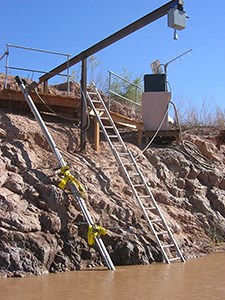
Satellite altimetry isn’t just an out-of-this-world idea; it’s a reality that beams down accurate data about the lake’s surface levels. Orbiting high above Lake Mead, satellites equipped with this technology bounce radar or laser signals off the water, capturing vital information on how high or low the lake stands. By tracking these levels from space, we can witness the ebb and flow of Lake Mead in almost real-time, complementing the data collected by gauging stations scattered along its shores.
On the ground, gaging stations play their part in the mapping puzzle. These gauging stations are carefully positioned around Lake Mead, ensuring that every cove and inlet is accounted for. They measure everything from water flow to temperature, offering a granular look at conditions that satellite altimetry might miss. Near the Hoover Dam, for instance, a cluster of these stations monitors the integral interface between human engineering and natural water cycles.
Each gaging station is a sentinel, standing guard over Lake Mead’s health. As they gather data on water levels and quality, this network forms a safety net that can alert us to potential issues. The science of measuring water at Lake Mead isn’t just for charts and reports; it’s a cornerstone of water management for the entire region. Through gaging stations data analysis, combined with the broader perspective from satellite altimetry, comprehensive mapping of Lake Mead becomes possible.
Against the backdrop of the stark Nevada landscape, the role of Lake Mead’s gaging stations is undeniable. They are the eyes on the ground that, when paired with eyes in the sky, keep a constant vigil on this precious desert oasis.
Monitoring Mead requires robust data collection, and the marriage of traditional gaging with space-born satellite altimetry offers an unparalleled view of the lake’s behavior. This marriage between old-school science and modern technology paints an intricate picture of Lake Mead, allowing researchers to predict trends, plan for the future, and maintain this crucial water source for thirsty populations. As technology advances and mapping strategies evolve, Lake Mead will continue to serve as a prime example of how we can sustain our natural resources, even in the middle of the desert. Keeping an eye on Lake Mead, through both gauging stations and satellite altimetry, isn’t just smart; it’s essential for the survival of the region.
The Hydrology of Mead: Understanding River Flow and Lake Levels
When we delve into the hydrology of Lake Mead, we’re embarking on a fascinating journey to understand the dynamics of water levels within this expansive river basin. USGS water data plays a fundamental role in this exploration, providing accurate insights into the ebb and flow of Lake Mead’s aquatic environment.
Situated near Las Vegas, Lake Mead’s vastness captures the imaginations of hydrologists and environmentalists alike as they gauge the lifeblood of the region—the Colorado River. The river’s flow feeds into Lake Mead, a cornerstone of the river basin, making monitoring of its water levels essential for predicting future water availability.
Through strategic placement of gaging stations, scientists can collect vital statistics on Lake Mead’s water levels. These gaging stations, especially those around the notable Hoover Dam, are integral to understanding the lake’s behavior. The science of measuring water levels at Lake Mead is robust, hinging on both traditional gaging methods and cutting-edge satellite altimetry. This dual approach allows for a comprehensive analysis, ensuring that Lake Mead’s data is not just accurate but also interpreted within the broader context of river hydrology and basin health.
It isn’t mere numbers that these gaging stations churn out; it’s a story, a narrative of Lake Mead’s interaction with its river source and the arid landscape it sustains. The data analysis derived from these stations is crucial, offering a window into the trends of river flow into Lake Mead. The role of Lake Mead’s gaging stations extends beyond measurement to assess the water resources that millions depend upon. The careful monitoring of these stations, aptly termed “Monitoring Mead,” proves indispensable for water management and conservation efforts.
Accurate data collection is not taken lightly in hydrological studies of Lake Mead. It serves as the bedrock of sustainable usage policies. USGS water reports generated by the gaging stations become a critical resource for decision-makers looking to balance ecological integrity with human needs. And then there’s the high-tech aspect: satellite altimetry complements the data collected on the ground. Mapping Lake Mead using satellite altimetry alongside gaging station locations means gaining a vantage point that earth-bound methods can’t offer alone.
Indeed, the hydrology of Mead cannot be mentioned without acknowledging the importance of river flow in driving lake levels. The inflow and outflow of Mead’s water reveal the pulsing heart of the river basin, a complex system where every drop counts. As Lake Mead continues to respond to natural and human-induced changes, the USGS water data and gaging stations act as our eyes and ears, a key to managing the challenges of water in the West. To appreciate the river, to safeguard the lake, and to understand the river basin’s future, Lake Mead’s hydrology must be studied with dedication and clarity. This dedication ensures that Mead’s story—one of nature’s marvels—is told with the reverence and accuracy it deserves.
Environmental Impacts and Water Quality at Lake Mead’s Gaging Stations
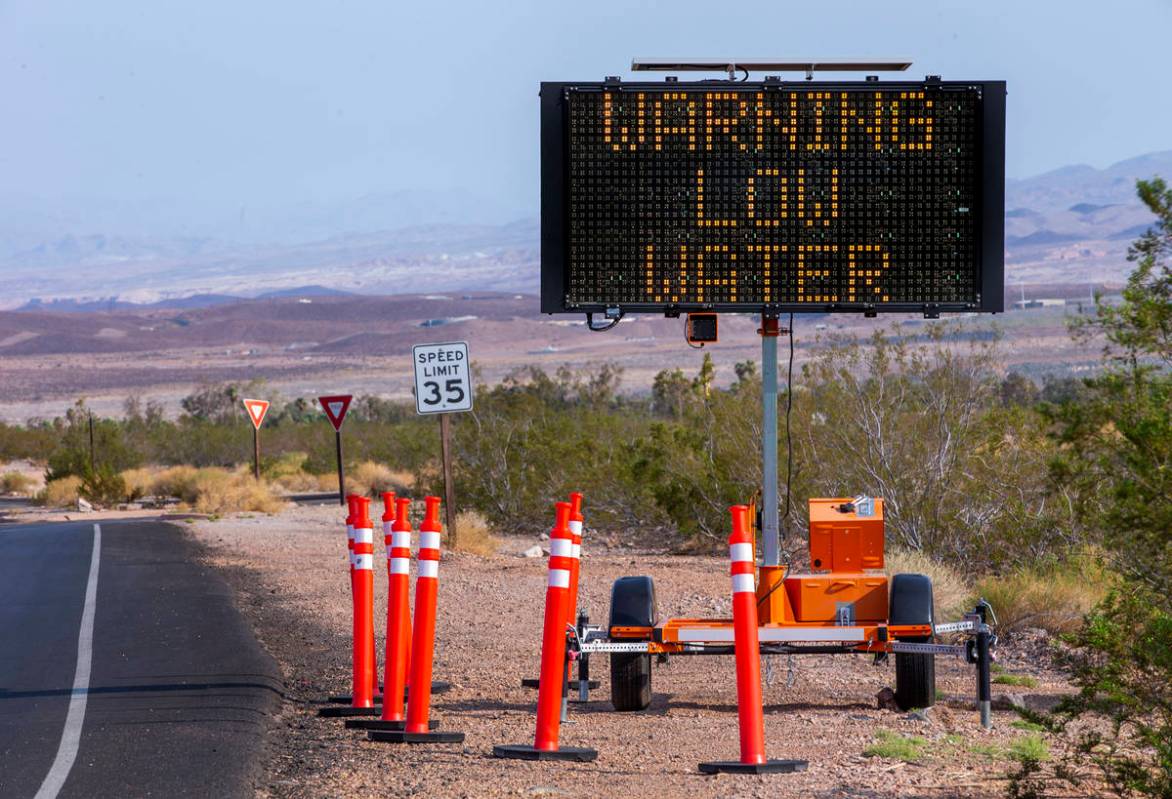
Lake Mead, a vast reservoir held back by the mighty Hoover Dam, is an essential water source for millions in the Southwest, including the bustling city of Las Vegas. Given its significance, the environmental impacts that affect this body of water are closely monitored, particularly at the lake’s gaging stations.
These gaging stations, vital for gauging water levels and quality, provide crucial water-chemistry data used to observe and address environmental health. The USGS water scientists and experts frequent these stations to assess water quality, ensuring that the chemistry of Lake Mead’s water is suitable for both ecosystems and human consumption.
Water chemistry data plays a key role in determining the health of Lake Mead. By analyzing samples for various chemical constituents, researchers can build a picture of the lake’s environmental state.
Substances like nutrients, heavy metals, and other contaminants are identified and quantified, guiding efforts to mitigate the negative environmental impacts on the lake’s aquatic life and its visitors.
At each gauging station, which can also be termed a gauging station, water quality is consistently checked, providing a data set that reflects changes in the water composition over time. This information is invaluable as it informs decision-makers about the state of the water resource and the actions required to protect it.
Integrating satellite altimetry with on-the-ground measurements at Lake Mead’s gaging stations enhances the understanding of water level variations in response to environmental changes.
The altimetry data, when aligned with the water-chemistry data from the gaging stations, can reveal the dynamics between the lake levels and the quality of the water, providing a more comprehensive picture of the lake’s overall health. This synergy is crucial as it allows for timely responses to detrimental changes in water quality or level, which can be caused by factors such as climate change or increased demand for water.
While the science of measuring water levels at Lake Mead utilizes sophisticated equipment, the ultimate goal is simple: to sustain a high-quality water resource. The gaging stations near Hoover Dam are particularly important as they not only monitor water levels but also act as sentinel locations for detecting early signs of environmental stress. This proactive monitoring helps to preserve the water’s quality, ensuring that Lake Mead continues to serve as a critical water supply in an arid region.
In conclusion, the gaging stations around Lake Mead are more than just points of data collection; they are guardians of environmental and water quality. The USGS water researchers are tasked with continuous surveillance, parsing through chemistry data, and interpreting quality measurements to maintain the harmony of this precious resource. As our understanding of Lake Mead’s hydrology deepens through the data provided by these gaging stations, efforts to combat the environmental impacts on its waters become more targeted and effective. Thus, the gaging stations are indispensable in safeguarding Lake Mead for future generations.
Conclusion
In conclusion, Lake Mead’s gauging stations and the use of satellite altimetry help scientists and researchers monitor water levels accurately. Located near Las Vegas, these tools play a vital role in managing water resources for the region. As the climate continues to change and population demands grow, the data provided by these stations remains crucial for sustainable water management and future planning. By understanding the precise locations of these stations and how satellite measurements complement them, we can better appreciate the complex efforts involved in protecting this precious resource.

References:
SNOWFLOW-Lake Mead Reservoir Levels
National Park Service-LAKE MEAD-RESERVOIR REPORT
FAQ’s
- What is Lake Mead? Lake Mead is the largest reservoir in the United States, located on the Colorado River near Las Vegas, Nevada.
- How was Lake Mead formed? Lake Mead was created following the construction of the Hoover Dam, which was completed in 1936. The damming of the Colorado River formed the reservoir, which serves as a critical water source for the southwestern United States.
- What is the current water level of Lake Mead? The water level of Lake Mead varies depending on factors such as precipitation, snowpack, and water usage. For the most up-to-date information on water levels, you can check official sources such as the U.S. Bureau of Reclamation.
- Why is Lake Mead important? Lake Mead plays a vital role in providing water for millions of people in the southwestern United States, including cities like Las Vegas, Los Angeles, and Phoenix. It also supports agriculture, hydroelectric power generation, and recreational activities.


